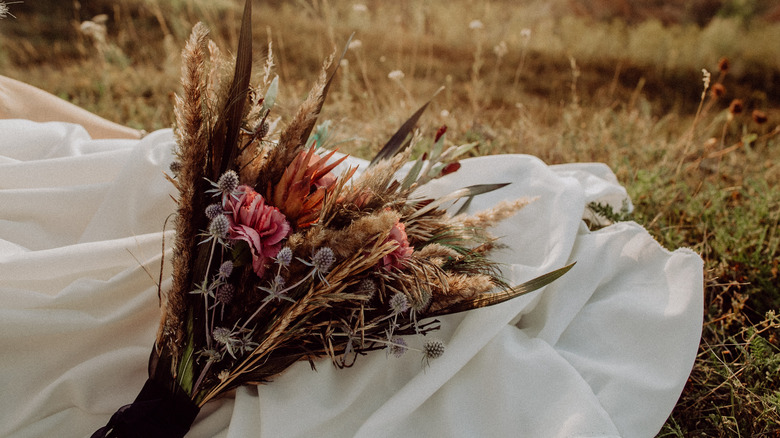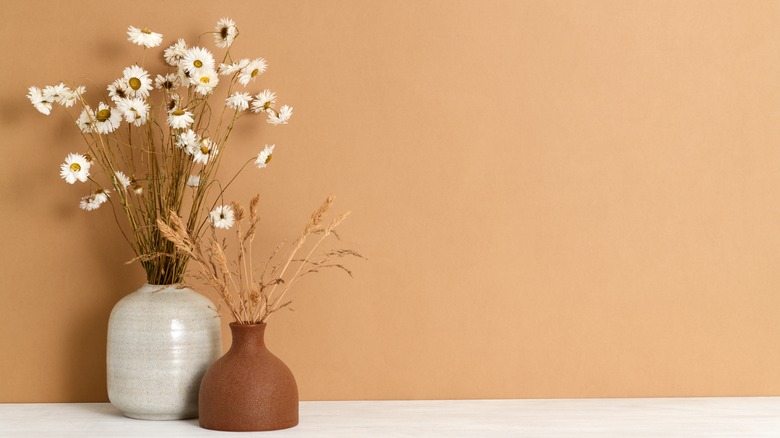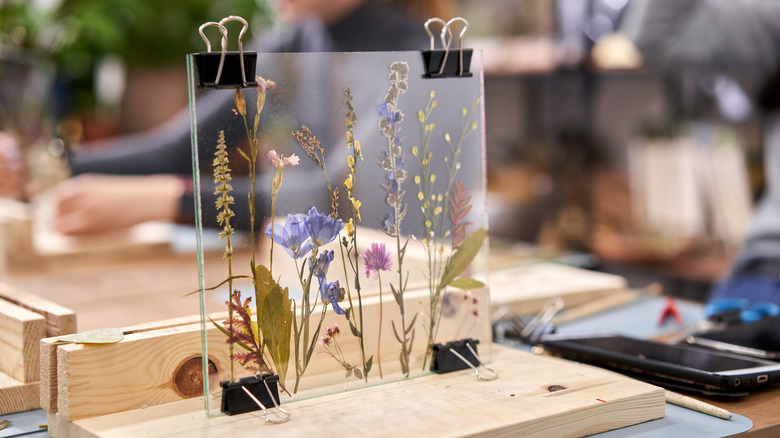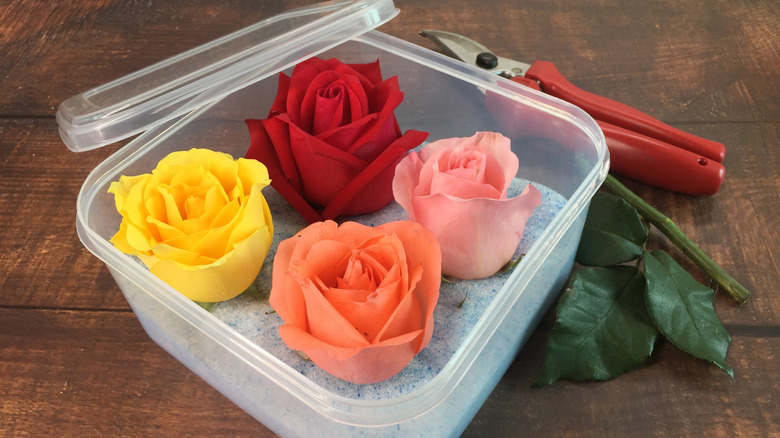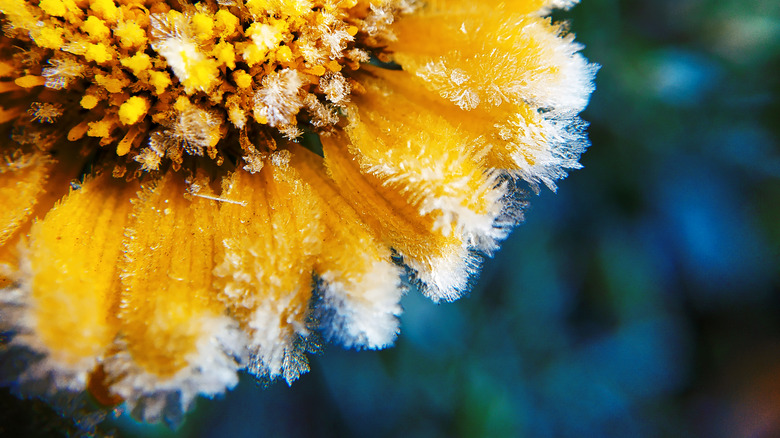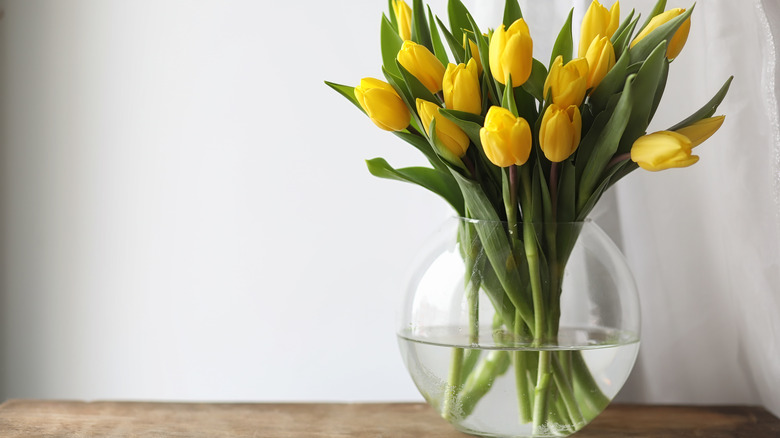Florist Shares The Best Ways To Preserve Flowers From Home
With more than 200 million views on TikTok, the dried floral trend doesn't seem to be dying out anytime soon.
All at once, pampas grass is everywhere: in homes, gardens, and weddings. "It all started because people are going for colors that feel a bit antiqued with a patina to them," explains Chris DeMeo, a wholesale florist in New York City to Martha Stewart. With a limited color palette available for fresh flowers, DeMeo says florists incorporated dried florals into designs to add the desired "vintage vibe." Kelsea Gaynor, founder and creative director of East Olivia in New York City told Martha Stewart that dried florals also expand a designer's toolkit, opening up a whole new range of textures, shapes, and dimensions, as well as colors.
But wedding color popularity was only one factor in why dried florals blossomed into the latest design trend; according to The Guardian, weddings canceled during the pandemic left many florists with fresh flowers that would have otherwise gone to waste.
If you're just looking to dip your toes into this trend, try adding an oversized vase of pampas grass or Italian Ruscus to add a flair of minimalistic boho-chic to a space, Itika Oldwine-Grimble of Oldvine Florals suggested to Architectural Digest. Taking the DIY approach to dried flowers, though, is really easy to do and Mary-Anne Da'Marzo, TikTok influencer and founder of the London-based preserved flower store, The Last Bunch, shared the best ways to dry flowers at home exclusively with The List.
Air-drying is the easiest way to do DIY dried flowers at home
The great part about taking advantage of the dried flower trend is that it's super easy to copy. If you're new to drying flowers yourself, Master Class suggests picking flowers that have small but sturdy blooms, like hydrangeas or lavender. Since these flowers already have a lower water content, they hold their shape and some color through the drying process.
Mary-Anne Da'Marzo, founder of The Last Bunch, shared with The List exclusively that the best way to air-dry your flowers is to hang them upside down. "For best results," she told us, "keep [your flowers] out of direct sunlight while drying them as this can affect the color of your flowers." Da'Marzo says this process takes 2 – 4 weeks. Your flowers have completed drying when they "feel rigid and have a gentle rustle," she added.
With air-drying flowers, while you can save a flower's stem, you do have to worry about shedding petals and mold growth, per PopSci. When you're tying flowers to hang them to try, make sure you're tying your stems tight enough that, if the stem shrinks, your flower won't fall, but without compressing the stem. Compressed and dense areas will hold moisture longer, making them more prone to mold.
When your flowers have dried, MasterClass suggests spraying the blooms with hairspray. This can help preserve the color and keep petals from falling.
Try framing pressed flowers saved from your wedding day
Pressing flowers has been rising alongside air drying flowers as a major trend floral. With over 140.6 million views on TikTok just for #pressedflowers alone, this is another easy, trendy way to turn flowers into keepsakes. Shops like Frances Foliage have even popped up, offering to press and frame bridal bouquets as a way to commemorate your big day.
Pressing flowers is a super simple way to preserve flowers at home, too. Mary-Anne Da'Marzo, founder of London's The Last Bunch, told The List exclusively that all you need are some thick books and wax paper. HGTV suggested putting down watercolor paper or cardstock under the wax or parchment paper — something to absorb the moisture from the flower.
To prepare your flower to be pressed, Da'Marzo told us you'll want to, "cut the stem of your flowers to the length you would like and find a thick book and place two sheets of wax paper on either side of the pages. Then place your flower at the centre of the open book on the wax paper." After you've carefully closed the book with your flowers inside, HGTV suggests placing more weight on top of the book you're using to press. You may find that flowers that have flatter heads and only one row of petals, like daisies and pansies, press the best, per MasterClass.
The main downside to pressing flowers is that pressing can take up to four weeks, says Da'Marzo.
Try using silica gel to preserve a flower's color
Air drying and pressing flowers are great, cheap, and easy ways to preserve flowers. The downside, though, is that you end up losing the flower's color and, in the case of pressing, organic shape. Using a desiccant — something that will take the moisture out — is a great option if you want to save the petal color, too.
Silica gel is what Mary-Anne Da'Marzo, founder of London's The Last Bunch, told The List she suggests. The process, she says, is easy. First, you'll want to make sure your flowers are free of excess water and unwanted leaves. Unlike other methods, using a desiccant can only preserve the heads, per Roxanne's Dried Flowers.
Next, you'll put some silica gel into an air-tight container. After you place your flowers in the gel, Da'Marzo says to add more so that your petals are covered but not "drowning" in silica gel. She says the process can take up to seven days, depending on the bloom size. Roxanne's Dried Flowers warns not to use flowers with blooms too small; they'll shrivel in the drying process. Silica gel works the best on flowers with big, bright blooms — think peonies and roses.
To speed the process along, Tobore Oweh, owner and creative director of The Petal Effect, told Insider you can put your microwave-safe container in the microwave, heat the mix for about a minute. After thirty minutes of cooling, your blooms are ready to go on display.
Yes, you can freeze-dry your flowers
Another way you can preserve flowers is by freeze-drying. The positive to freeze-drying is that, as Mary-Anne Da'Marzo, founder of London's The Last Bunch, told The List exclusively, the process takes "all of the moisture out of the petals and keeps them smelling and looking fresh." The downside? Freeze dryers can be expensive, explains Da'Marzo.
According to Roxanne's Dried Flowers, to preserve flowers through the freeze-drying process, flowers are placed in below-freezing temperatures while a vacuum pump slowly pulls the moisture out of the air and flower. So, unfortunately, you can't just stick your fresh flowers in the freezer; you need an actual freeze dryer, per Garden Guides.
This not only preserves the flower's smell like Da'Marzo said, but freeze-drying also preserves a flower's color and shape at the time it was freeze-dried. So while this may keep your flowers looking the most realistic, freeze-drying is hard to do well at home.
To help the freeze-dry process at home, Garden Guides recommends letting your flowers "drink" up water in a vase (give the bottoms a fresh cut first!) for at least 12 hours before you freeze-dry them. The shorter and smaller the flowers are, the faster they'll freeze-dry, but Garden Guides says it can take 10 to 15 days for your flowers to properly freeze-dry. You'll know they're ready when they're no longer cold to the touch; freeze-dried flowers have no moisture in them, so they don't have a temperature.
If all else fails, try glycerin
Glycerin, according to Roxanne's Dried Flowers, is one of the most popular ways to preserve flowers. However, the process is intricate and time-consuming, making it a hard process to duplicate at home.
The process is simple, in theory. As Mary-Anne Da'Marzo, founder of London's The Last Bunch, told The List exclusively, all you need to do is place freshly-cut flowers in a mixture of "one part glycerin and two parts warm water." Da'Marzo says to leave your flowers in the mixture for two weeks before you start checking on them. When they're ready to be taken out of the glycerin, she says the flowers will "feel rubbery." Processing time, according to Hello Lidy, will change depending on the flower; flowers with thinner petals, like alstroemerias, will take less time than those with thicker, like roses.
While this sounds easy enough, Roxanne's Dried Flowers warns that only flowers harvested at the right time will work the best in glycerine. You'll want to use fully mature flowers; new growths will reject the glycerin, which is why you should wait until flowers have fully matured, which is about mid-season.
Plus, DIY glycerine projects won't preserve colors the way they do when professionals do it. While "Hello Lidy" says flowers like Gerbera Daisies, Bells of Ireland, Magnolias, Tulips, and Ranunculus work great for preservation, you will lose coloration during the drying process. Often, food color is added to glycerine solutions to help preserve petal or stem color.
